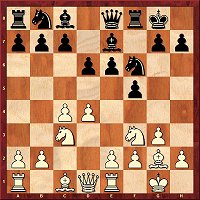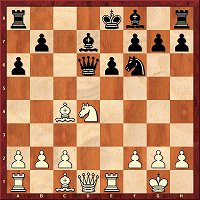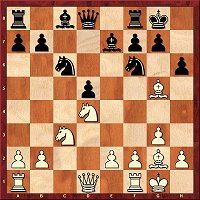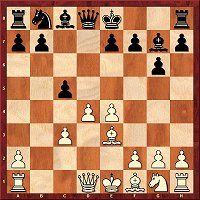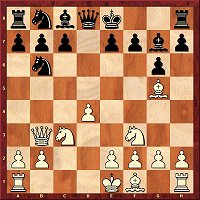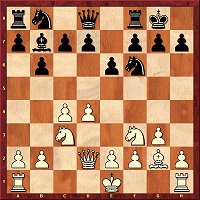 | Introductory video
In his compact introductory video grandmaster Dorian Rogozenco gives you an overview of the many joys on offer to you in this issue and shows you the occasional highlight, e.g. the decisive moments from the game Kramnik-Ponomariov from the first round of the Dortmund tournament. Rogozenco takes a special look at Igor Stohl’s opening article on the Grünfeld Defence with Be3 and the innovation 13.h4, introduced by Kramnik in Dortmund against Giri. |
| 02.09.-03.09.2011 
Not in need of practice:
Vishy Anand
| Top 4 in Moscow Whereas other top players require game practice - really true for rapid chess - this apparently is not the case for Anand. The last tournament in classical chess played by the world champion was back in January in Wijk aan Zee, and the Indian player won a rapid chess match against Shirov at the start of June. And now no less than the top 4 in a double round robin in Moscow in the honour of Mikhail Botvinnik. But Anand was majestic and was very dangerous above all with the black pieces, see also the game in the next section. A lead of 1.5 points over the short distance of only six games is considerable. Though first in the world ranking list, Magnus Carlsen came in a clear last on the other hand. Yet the first day was quite normal for him - three draws. But when on day two the Norwegian spoiled a promising position against Aronian, he went on to pull out all the stops and promptly lost all his games. |

Aronian,L - Anand,V
Position before 13...e5
| The Schlechter Defence has rarely been played by the world champion before, but it suits him well because it often provides opportunities to counter-attack. In the only decisive game of the first day (Anand only had one Black) this was exactly the opening which appeared, in which with an almost symmetrical setup it is White who tends to have an advantage. But with 12.Qe2 Aronian placed his queen on the same file as the rook on e8, which did not meet with the approval of Michal Krasenkow. Anand promptly played 13...e5! and Black took the initiative. After 14.dxe5 Nxe5 came the next mistake with 15.Be1?, because 15...Nxf3+ 16.Qxf3 Qb8! brings the dangerous threat of ...d4 and all Aronian could do was 17.Qf4, which after 17...Qxf4 18.exf4 left Anand with a clearly advantageous ending. |
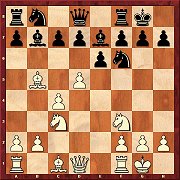
Kramnik,V - Carlsen,M
Position before 9.Bf4
| Magnus Carlsen was not in top form in Moscow, as can be seen from his choice of opening against Vladimir Kramnik. After 1.Nf3 he went for 1...b5?! 2.e4! Bb7?! 3.Bxb5 Bxe4, with the commentary symbols added by Mihail Marin. The Romanian grandmaster means that the operation with the black bishop costs too much time and the gain of a central pawn does not make up for the loss of tempo. Even in the Orang-Utan (1.b4 e5 2.Bb2 Bxb4 3.Bxe5 this strategy is doubtful, but Carlsen was trying it out with a tempo less. In the position in the diagram Kramnik continued with the natural 9.Bf4, whereas previously 9.Ba4 had been played very frequently. But Marin points out that 9...c6? need not be feared, because it is simply followed by 10.d6!. But after 9...Na6 10.Re1 too, Kramnik got a big advantage and safely converted it. |
| 08.08.-15.08.2011 
Peter Svidler
Champion for the 6th time
| Russian Championship All the top players were present for the 64th Russian Championship, and this year even Vladimir Kramnik climbed into the ring and in doing so raised the average Elo to over 2700 points for the first time. The favourite for the title was therefore there, but his ambitions were smothered in the very first round by Peter. And whereas Kramnik thereafter found it very difficult to get back into the tournament, Svidler not only completed a hat-trick of wins between rounds 4 and 6, but in doing so secured victory in the tournament before the final round was even played. In the said final round Svidler was able to allow himself a slight slip and lost his game with Alexander Morozevich, who once more put in a splendid performance and finished the tournament in second place, just as he had done in Biel. |

Timofeev,A - Svidler,P
Position after 27...f6
| One milestone on the way to the title was Peter Svidler’s victory with Black over Artyom Timofeev in the fifth round. Whilst Morozevich was being crushed by Nepomniachtchi, Svidler’s opponent was missing a beautiful probably winning continuation in the position on the board on the left. Instead of 28.Nxe3 Timofeev could have had the surprising tactical shot 28.Ra7. Since after 28...Rxd1 29.Qxd1 Qxd1 30.Rxe7+ Rf7 31.exf6+ Kxf6 32.Rxf7+ Black loses a piece, and after 28.b3 29.Bxb3 cxb3 30.Raxd7 Bxd7 31.Qb7 Bc6 32.Rxd8 Bxb7 33.Rd7 White gets an endgame with a sound extra pawn on the b-file. However, Timofeev completely lost the thread and just a few moves later lost his queen which had been forced to the edge of the board. |

Morozevich,A - Grischuk,A
Position before 32...a5
| After his comeback to the world of chess Alexander Morozevich had in Moscow a third successful tournament in succession with an ELO-performance of over 2800. On the DVD you will find his three wins with White against Grischuk, Svidler and Timofeev with extensive analysis on each by Michal Krasenkow. Against Grischuk the comeback kid showed clearly that it is still possible to win with the Exchange Variation of the Queen’s Gambit . In the variation with 3...Be7 and 5.Bf4 Morozevich first played the extremely rare 7.h3 and went on to place his queen in rather unorthodox fashion on e2. As Krasenkow points out in his analysis, this did not bring Morozevich an opening advantage, and the subsequent sacrifice of queenside pawns did not create the hoped for attack on the black king. So he required a little cooperation on the part of Grischuk. In the position on the board the latter overlooked the only white threat and played 32...a5. Can you see how Morozevich was then able to bring his attack to a successful conclusion? |
| 21.07.-31.07.2011 
No compromises:
Vladimir Kramnik
| Dortmund The Dortmund Sparkassen Chess Meeting is and remains Vladimir Kramnik's tournament. In 1995 he won in Dortmund for the first time, and this year, 2011, he celebrated his tenth victory in this strong and famous tournament. Kramnik started majestically and at the end his 7 out of 10 left him, despite a final round defeat at the hands of Hikaru Nakamura, a whole 1.5 points ahead of the Vietnamese player Le Quang Liem. The only person who will ever be able to break Kramnik's "Record for eternity" will be Kramnik himself. The first attempt at that will be summer 2012. |

Nakamura,H - Kramnik,V
Position after 15...Ba4
| For this ChessBase Magazine the serial victor of Dortmund has chosen to annotate his win against Hikaru Nakamura. The American went into a theoretical duel in the Nimzo-Indian and chose an unfashionable variation with 8.Qb3. However, Kramnik points out in his analysis that in his day Kasparov championed this move. And especially since Kramnik knew that Nakamura had been working with Kasparov recently, he would probably not have been all that surprised at the choice. White’s plan does not come out of Kramnik’s analysis of the opening phase all that well, and in the position on the board after 15...Ba4 it is in fact Black who is beginning to plague his opponent with annoying moves. Kramnik completely fails to understand Nakamura’s decision not to immediately liquidate to a drawn rook ending in their rook+bishop against rook+knight endgame. Punishment followed on the spot because the ex world champion demonstrated to his opponent how to win an ending of this type. |

Kramnik,V - Ponomariov,R
Position after 19.Na4
| A pointer to Kramnik’s new success was his first round victory over Ruslan Ponomariov, which is annotated in great detail on the DVD by the Ukrainian loser. Ponomariov, who won the Dortmund Tournament last year thanks in part to a second round victory over Kramnik, wanted to repeat things this year and with his choice of the King’s Indian went all out. And he was a hair’s breadth away from success. In his analysis Ponomariov indicates several dubious moves and missed chances for both sides. In the position on the board on the left Kramnik deliberately allowed after 19.Na4 the blow 19...Nxe4. One possible variation goes 20.Qxe4 Bxb3 21.axb3 Rxe4 22.Bxe4 Bxa1 23.Rxa1 Re8 with very good play for Black. But the Ukrainian let himself be bluffed by his opponent’s cool and chose in 19...Bc4 an equally spectacular but sub-optimal continuation. As this highly complex struggle developed, Kramnik took the initiative with an exchange sacrifice and won through in the endgame too thanks to his opponent’s time trouble. Click on the link under the diagram and play through the game with Ponomariov’s comments. |

Ponomariov,R - Giri,A
Position after 25...Rd8
| Who knows how the tournament would have turned out if the first round had seen a different result? However, Ponomariov did not allow himself to be cast down by his defeat and scored wins in rounds 2 and 3 over Giri and Nakamura. Ponomariov also annotates on the DVD his win with White over the young Dutch player. But here he shows himself less euphoric about his own play especially in the opening. After Giri’s (almost) innovation 11...b4 Black not only solves his problems but already a few moves later it is White who has to play with due care and attention. But no matter how well Giri handled the opening, more and more question marks are awarded to his middlegame moves in Ponomariov’s analysis, and after the final mistake 25...Rd8 (diagram) the game was already essentially over. Can you find the winning continuation for White? |

Once again 5.5 out of 10 for
Le Quang Liem
| Ponomariov’s dream of a defence of his title must already have disappeared in round 5. Whilst Kramnik moved on to 4.5 after his win over Giri, the Ukrainian suffered his second defeat this time against Le Quang Liem. For Le Quang this would be his only win in Dortmund, he drew all his other nine games and that was enough for him to finish in second place. The Vietnamese also annotates two of his games in this issue, naturally including his win against Ponomariov. |
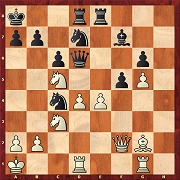
Le Quang,L - Ponomariov,R
Position after 29...Nc4
| The two players stalked each other in the Exchange Variation of the Queen’s Gambit with 7.Bf4, with first White and then Black choosing to castle long and then they tried to optimise their position by clever manoeuvring. Firstly, after a lack of concentration by Ponomariov (27...Bf7) Le Quang forced the play with pawn advances on the kingside and in the centre. Perhaps the most critical position in the game was reached after 29...Nc4 (diagram). Here Le Quang turned to 30.Nb3, which according to his analysis would have led to equality after 30...Bg8 31.d5 cxd5 32.Nb5 Qb8 33.exf5 a6. On the other hand the continuation 30.exf5 Ne3 31.Ne4 Nxd1 32.Nxd6 Nxf2 33.Nxf7 gxf5 34.Nxd8 Rxd8 35.Rf1 would have promised a clear advantage. But Ponomariov did not see his way through correctly either and so he decided to exchange queens by means of a pawn sacrifice by 30...Qb4 31.d5 Qb6. The wrong decision, because Le Quang logically played out the resulting endgame to victory. |
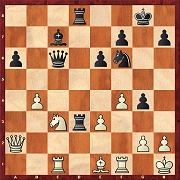
Nakamura,H - Le Quang,L
Position after 30.Be1
| Nakamura-Le Quang saw a theoretical duel in what is at present a very popular variation of the Semi-Slav with 9...a6 and 12.Bd2, in which White has in the last two years been able to achieve very good results (see Krasenkow’s theoretical article in ChessBase Magazine 142). In the game the American innovated with 14.b4, but according to Le Quang’s analysis this does not set Black any real problems. The course of the game proved him correct, because by placing the two bishops on the a8-h1 and b8-h2 diagonals, followed by the advance 22...g7-g5 the Vietnamese player clearly got the upper hand. In the position on the board, however, he missed good winning chances with the text move 30...Rxe3. They would absolutely have been there after 30...Nd5 31.Ne2 Qb7 32.e4 Ne3 33.Rg1 Rd1 34.Qb1 Rxc1 35.Qxc1 Bb6. So Nakamura seized the chance to simplify the position with 31.Qf2 and to steer into drawish territory. |
18.07.-29.07.2011 
Magnus Carlsen
Who else?
| Biel The 44th Chess Festival in Biel witnessed a win by the favourite which was never in doubt. Magnus Carlsen won five of the first seven games, and so victory in the tournament was assured after the penultimate round. The basis for the Norwegian’s success was once again his pressure play and his unerring feeling for errors on the part of his opponents. Second place went to Alexander Morozevich, and perhaps even more could have been possible on his return, had there not been his defeat at the hands of Caruana in the ninth round. |

Shirov,A - Carlsen,M
Position before 16.dxe5
| An example of the fighting and by no means error-free chess in Biel can be found in Magnus Carlsen’s game as Black against Alexei Shirov which he has chosen to annotate for this issue. In the Anti-Berlin Variation of the Ruy Lopez Shirov tried after 4.d3 Bc5 5.c3 0-0 the move 6.Bg5 – a variation which has found few imitators at the top level after Anand-Topalov 2005. After the intermediate move 6...h6 7.Bh4 the Norwegian deviated from well-trodden paths with the innovation and apparent loss of tempo 7...Be7. As Carlsen explains in his analysis, his follow-up was too optimistic and in the position on the board his opponent could have emerged from the complications with the better chances after 16.h3 Nxe3 17.dxe5 dxe5 18.h4 Bf4 19.Bf2 etc. After the immediate 16.dxe5 dxe5 17.Bxe5 Shirov did win a pawn in the game. But in return, in what followed the Spaniard found himself faced with ever greater problems concerning the safety of his king, and in the transition to the endgame Carlsen snatched four of his opponent’s pawns in a few moves. |

Carlsen - Shirov
ChessMedia Format
| It was not only due to his numerous wins that Magnus Carlsen was a frequent and welcome guest on the Live analysis with GM Cebalo. On the DVD you will find four ChessMedia clips, in which the world no. 1 talked to camera about his games. The game Carlsen-Shirov in the second round followed after the rare 13...e5 in the Meran Variation first of all the game Gelfand-Dreev (Tilburg 1993), which Carlsen also correctly quotes in the Live analysis. In the game the innovation and improvement over the previous game was 16.g3. Because unlike 16.Qf3 the text move leaves the black knight offside, and the white knight on h6 prevents Black from castling short once and for all. Click on the link under the photo and the super-star from Norway will explain the game to you. |

Carlsen - Pelletier
ChessMedia Format
| In the game Carlsen-Pelletier the Swiss player tried his luck in the French Defence with 3...dxe4 4.Nxe4 Nd7 5.g3 Be7 and actually came out of the opening with an advantage. Pelletier did not make the decisive mistake till the endgame, when he apparently developed some activity with the tempting 25...Rd1+ and went on to open the position unnecessarily with 26...f5 (see diagram). Actually these moves finish by helping White to further open the position with 27.Bf3 and to make it more suitable for his bishop pair. In their analysis the two commentators agree that the position here is extremely dangerous one for Black to play, and Carlsen demonstrates at the end at full speed another nice mating motif. |

Vachier-Lagrave analyses his
victory over Carlsen
| Carlsen only had to admit defeat once in Biel. Against Maxime Vachier-Lagrave the Norwegian under pressure missed the correct moment to start developing some activity and was for too long over-confident about the possibility of holding his position. Vachier-Lagrave increased the pressure on the cramped black position and finally won the game in the double rook ending by using zugzwang motifs. Vachier-Lagrave himself annotates the game in ChessMedia format and in his endgame column Karsten Müller also puts the subtleties of the winning plan under the microscope.
In the return game Carlsen-Vachier-Lagrave the Norwegian was not able to put the top French player in any real danger in order to get revenge for his defeat. On the DVD both participants comment in an extensive conversation on this game which was hard-fought all the way into the endgame. |

Carlsen - Morozevich
ChessMedia Format
| Alexander Morozevich had another excellent result with four victories and only a single defeat at the hands of Caruana and occupied second place just behind Carlsen. On the DVD he comments, e.g., together with Carlsen, on their game from round 8 in which Carlsen only got a minimal advantage from the opening (Vienna Variation of the Queen’s Gambit Declined). In their analysis the two top players rush through several tactical subtleties – of which the opposing side had always been aware. |

Caruana - Morozevich
Position after 15...Na4
| The Russian also annotates in ChessMedia format the game Caruana-Morozevich in the Catalan Opening. Caruana probably gave away a tempo with the rare move 11.Rd1. Morozevich took advantage of this circumstance and extended his pressure on the white position with a placing of his minor pieces on the queenside which is worth seeing (see diagram). As things went on, Caruana lost a pawn and then in time trouble made the mistake of exchanging queens. Click on the link under the diagram and have Morozevich explain the game to you from the first to the last move. |
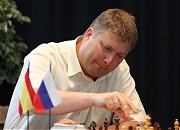
Shirov - Caruana
ChessMedia Format
| Alexei Shirov produced a masterpiece of his own sort. In the second round of games he had a duplicate of the results he achieved in the first flight, scoring exactly the same against each player. Two defeats against Carlsen and two wins over Caruana (the remaining games all being drawn) left Shirov with 50% as the solid middle field in the table along with Vachier-Lagrave. In the video analysis of the game Shirov-Caruana the Spaniard spends a lot of time, as he did in the last ChessBase Magazine, explaining in detail the opening phase too (Shirov’s Bishop’s Opening was another surprising choice). But Caruana had no problems equalising, but in the middlegame the young Italian looked for too much and finally lost to a mating attack by Shirov. In another video analysis Shirov comments together with GM Cebalo on his first round game Shirov - Morozevich (French with 3...Nf6). |
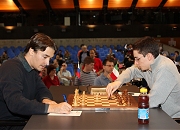
Morozevich - Caruana
ChessMedia Format
| In the last round but one Fabiano Caruana had his revenge on Morozevich for his defeat in the first series of games and destroyed the latter’s last hope of winning the tournament (in the same round Carlsen secured in advance first place with a draw with Vachier-Lagrave). In the game, in the popular Anti-Moscow Variation of the Queen’s Gambit, Morozevich innovated with 13.Qf4. But for Caruana this "logical" move was no surprise. In his Live analysis the Italian points out that he “had already analysed this move some years ago“. However, after the exchange of queens Black is faced with a difficult task in a very complex position. In his analysis which lasts almost half an hour, Caruana indicates improvements for both sides. In the game Caruana managed to bring his king effectively into the action and thus take advantage of his queenside pawn majority. |

Pelletier - Vachier-Lagrave
ChessMedia Format
| Things were just as bad for Yannick Pelletier in Biel as they were for Georg Meier in Dortmund. The Swiss GM too did not win a game, he too had his chances. Together with Vachier-Lagrave he delivered some real tactical fireworks in his Live analysis of their game in the King’s Indian in round three. Nevertheless, both players came to the conclusion in their analysis that in the game they had been calculating to quite some depth but not always correctly. In a rare variation with 12...Be6, Vachier-Lagrave sacrificed a knight on d5 early on and was able to save himself with perpetual check at the end. On the DVD you will find in addition to the video Pelletier’s extensive game analysis in classical format, inwhich he comes to definitive evaluation of Black’s knight sacrifice. Moreover, the Swiss player has annotated for the DVD another game of his, Pelletier,Y - Shirov,A. |
| 17.07.-26.07.2011 
Levon Aronian led
his team to gold
| World Team Championship in Ningbo Armenia is a chess country par excellence. In spite of having just 3.2 million inhabitants, it occupies sixth position in the national ranking lists and in every major event at national level it has for years been one of the favourites. This was the case this year too in the World Team Championship in Ningbo in China. With Aronian, Movsesian playing for Armenia for the first time, Akopian and Sargissian they again had a powerful squad, which managed to complete all its matches without a loss and to win five of its nine encounters. And on this occasion that was enough to win the WTCh title. The Elo favourite teams from Russia and Azerbaijan disappointed all along the line. In the final round the Russian team blew their last chance of a medal with their defeat at the hands of India, which moved Evgeny Bareev to resign from the post of national trainer. |

Aronian,L - Karjakin,S
Position before 17.Nxc6
| The teams from Armenia and Russia met as early as round 3, when things were still up for grabs for the top favourites. The match ended 2:2, partly thanks to Levon Aronian’s win against Sergei Karjakin, annotated for you on the DVD by the Armenian No. 1. After a painful defeat by Kamsky the previous day, Aronian set about things in an extremely motivated way in this game and in the position on the board on the left from the Meran Variation unveiled an astounding idea. The position actually looks peaceful – but here Aronian struck home with his knight on c6 and after 17...Bb7 18.Nd4 Nxb3 19.Qxb3 retained a full (if isolated) extra pawn. In the transition to the queen ending, Aronian returned the pawn for the initiative and gave a masterful demonstration of the principle of "domination". Click on the link under the diagram and play through the game with Aronian’s comments. Tip: Karsten Müller devotes a video to this ending in the endgame column. |

Nepomniachtchi,I - Sasikiran,K
Position after 42...Qe8
| The team from India arrived without World Champion Anand and therefore was not in contention, as one might expect. Their prestigious last round victory over Russia therefore came as something of a surprise and was somewhat fortunate. Krishnan Sasikiran was one of the two stumbling stones in this match in his game against Ian Nepomniachtchi. In it he first surprised his opponent with the bold innovation 9...d5 against the latter’s Keres Attack and was lucky to reach the middlegame with equality. In his analysis Sasikiran points out numerous mistakes by both players and describes the circumstances which considerably influenced the result of this game. In the position on the board on the left White could liquidate directly to a drawish endgame with the exchange of queens. But in view of the match score of 1.5:1.5 Nepomniachtchi scorned this safe continuation – with fatal consequences in view of the open white king position. On the DVD Sasikiran also annotates the game Almasi,Z - Sasikiran,K. |
| | |

Cyborowski - Markowski
How can Black win?
You will find the solution in Karsten Müller's endgame column
| From the opening trap to the endgame study
Training in ChessBase Magazine starts with the very first moves and includes all the phases of a game of chess. The 11 up-to-dateopenings articles with their many ideas and suggestions for your repertoire can be found above among the links. Rainer Knaak’s opening trap (including its Fritztrainer video) contains this time a trap in the Scotch (C44). You will also find in video format the openings contributions by Leonid Kritz (French Winawer Variation), Valeri Lilov (Caro-Kann Advance Variation) and Adrian Mikhalchishin (Semi-Slav with an early ...a6). These videos can be found in the fritztrainer column. The subject of Peter Wells in his strategy column is called: "Capturing towards the centre?". In Daniel King’s long running Move by Move it is a game in the Catalan which is there for training. And in the tactics column (theme: happiness without queens) and endgames column (theme: double rook endings) Oliver Reeh and Karsten Müller have once more brought together for you all that is best from recent tournament practice.
|
































